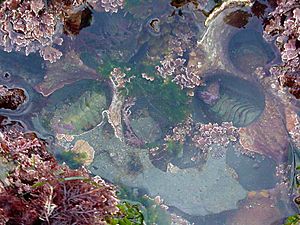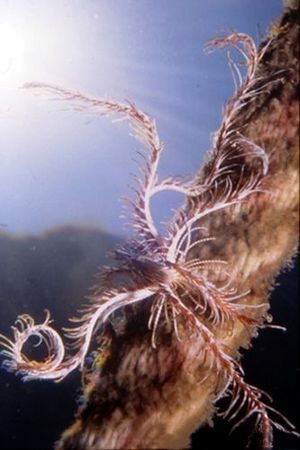Mesozoic marine revolution facts for kids
The Mesozoic marine revolution was a big change in the oceans long ago. It was a time when many new types of predators appeared on the sea floor. These predators loved to eat shellfish, like clams and oysters.
This change happened during the Mesozoic Era, which was about 252 to 66 million years ago. Before this, sea creatures were different. But during the Mesozoic, predators like starfish, snails (called gastropods), and crabs became very common. They are still common today!
Each of these predators had clever ways to get to the soft parts inside a shell. Crabs would simply crush the shells with their strong claws. Some snails could drill holes into shells. Others might find tiny cracks to get their feeding tube (called a proboscis) inside. Even some sponges could bore into shells! Also, some ancient marine reptiles, like placodonts, ichthyosaurs, and mosasaurs, had flat teeth perfect for crushing shells.

How Starfish Hunt Shellfish
Starfish are one of the most common shell-eating predators. Shellfish like clams and brachiopods hold their shells tightly closed with strong muscles. A starfish uses its many tiny tube feet to grab onto both sides of the shell.
Then, the starfish pulls steadily. It has a powerful hydraulic system that lets it pull for a long time. The shellfish's muscles can't hold on forever! Usually, after about ten minutes, the shell opens just a little bit.
Once there's a tiny gap, the starfish does something amazing. It pushes its own stomach out of its mouth and into the shell! Its stomach can squeeze through a gap as small as 0.1 millimeters. Inside the shell, the starfish dissolves the soft body of the shellfish. It then absorbs all the nutrients. This digestion process can take a couple of days.
Some starfish species even swallow small shells whole. They digest the contents inside their body, then spit out the empty shell later.
Changes in Ocean Life
The ability of starfish to eat shellfish became very common during the Jurassic and Cretaceous periods. This led to big changes in the creatures living on the sea floor. Shellfish that were weak or couldn't move much started to disappear.
Instead, shellfish with stronger shells or those that could move quickly began to thrive. This was a huge advantage for any shellfish that could defend itself.
- Many shellfish developed extra-tough shells to protect themselves.
- Some learned to burrow deep into the sand to hide.
- Scallops developed the ability to swim away quickly. This skill improved over time because of natural selection. Scallops became very common during the Mesozoic Era.
Some scallops even have special tricks. For example, a scallop called Chlamys hastata often carries sponges on its shell. This is a type of mutualism, where two different species help each other. The sponge makes it hard for starfish to grab onto the scallop's shell. It also helps to camouflage the scallop, hiding it from other predators.
When scallops swim off the sand, they can face new dangers. Predators like rays might patrol just above the ocean floor. Seabirds might also pick them up and drop them on rocks to break their shells. But getting away from starfish, which are very numerous near the shore and on the continental shelf, is a huge benefit for scallops.




